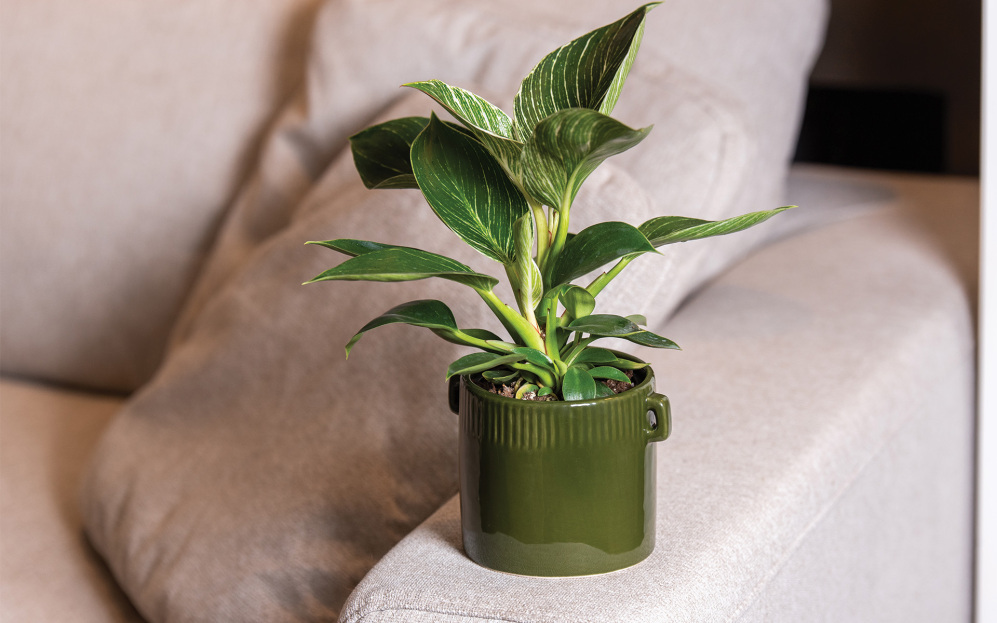
Elegant, striking, and resilient, the Philodendron Birkin is a delightful addition to any indoor plant collection. Originating from the tropical regions of South America, this plant is characterized by its glossy, heart-shaped leaves adorned with striking white variegation. The best part is that caring for this plant is rewarding for both new and experienced plant lovers. In this guide, we'll explore the ins and outs of Philodendron Birkin care, ensuring that your indoor jungle flourishes with its beauty.
Providing the right amount of light is crucial for the health and growth of your Philodendron Birkin. While it can tolerate low to medium light conditions, it thrives in bright, indirect sunlight. Position your plant close to a window where it can get indirect sunlight all day. Prevent direct sunlight exposure, as this can lead to sunburn and harm its fragile leaves.
Achieving the perfect balance of moisture is essential for the well-being of your Philodendron Birkin. Water the plant when the top inch of soil feels dry to the touch, ensuring thorough but not excessive watering. Allow excess water to drain away freely from the pot to prevent waterlogging, which can lead to root rot. If watering into a pot without drainage holes, be sure to discard any excess water in the bottom of it pot after watering. During the winter months, reduce watering frequency to accommodate the plant's slower growth.
As a tropical plant, the Philodendron Birkin thrives in high humidity environments. It can handle average humidity levels. However, it will do better with regular misting or being near a humidifier. This is especially important during dry winter months. Grouping plants together can also help create a microclimate of increased humidity around them.
Maintain a consistent temperature range of 65°F to 80°F (18°C to 27°C) to keep your Philodendron Birkin happy and healthy. Avoid exposing it to drastic temperature fluctuations, drafts, or cold air, as these can stress the plant and hinder its growth. Providing adequate airflow around the plant will help prevent fungal issues and promote overall well-being.
Choose a well-draining potting mix rich in organic matter for your Philodendron Birkin. A mixture of peat moss, perlite, and potting soil works well to provide both moisture retention and adequate drainage. Repot your plant every couple of years or when it outgrows its current pot, typically in the spring or early summer.
Fertilizing a Philodendron Birkin is essential for maintaining its vibrant, variegated foliage and healthy growth. Use a balanced, water-soluble fertilizer (such as a 10-10-10 or 20-20-20 formula) diluted to half strength to avoid overfeeding. During the active growing season, typically spring and summer, fertilize every 4–6 weeks. Be cautious not to fertilize too frequently, as this can lead to salt buildup in the soil and damage the plant's roots. In fall and winter, when the plant’s growth slows, reduce or stop fertilizing altogether. Always water the plant before applying fertilizer to prevent root burn, and consider using an organic fertilizer or one formulated specifically for houseplants to provide steady, gentle nourishment. Regular feeding will help the Philodendron Birkin maintain its characteristic white and green striped leaves.
Regular pruning is essential for maintaining the appearance and health of your Philodendron Birkin. Trim away any yellowing or damaged leaves to encourage new growth and maintain its compact shape.
While Philodendron Birkins are relatively resistant to pests and diseases, they can occasionally attract common indoor plant pests such as spider mites or aphids. Regularly examine your plant for any indications of pests or irregularities, and quickly address infestations using organic insecticidal soap or neem oil.
To propagate a Philodendron, take a stem cutting just below a node with at least one leaf. Remove the lower leaves and either place the cutting in water, ensuring the node is submerged, or plant it directly in well-draining soil.
Keep the cutting in a spot with bright, indirect light and change the water every few days if using the water method. Roots should develop within 2-6 weeks.
For division, carefully remove the plant from its pot, separate sections with their own roots, and repot them individually. Keep the new plants in a warm, humid area and water lightly.
Smaller new leaves can be a sign of insufficient light, lack of nutrients, or the plant becoming root-bound. Repotting, fertilizing, and providing more indirect light can help the leaves grow larger.
Your Philodendron Birkin may be losing its white color due to insufficient light, as it needs bright, indirect light to maintain its variegation. Low light can cause the leaves to turn more green. Aging leaves naturally lose their variegation over time, and nutrient deficiencies, especially in nitrogen or potassium, can also reduce the white patterns.
Environmental stress, such as temperature changes or overwatering, can further contribute to the loss of variegation. Ensuring proper light, nutrients, and consistent care can help maintain the plant's unique coloring.
No the Philodendron is considered toxic to pets according to the ASPCA.